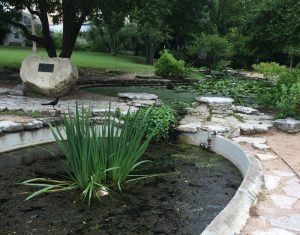Fifty years ago, on August 1, 1966, twenty-five year old student Charles Whitman killed 16 people and wounded at least 32 more at UT Austin. A former Marine sharpshooter, he went to the 28th-floor observation deck of the UT Tower and began shooting people on the ground as they walked by or tried to hide. A news cameraman set up a camera under the tower so the shooting was broadcast on television. Several police officers and a recently retired Air Force officer made their way to the top of the tower not knowing what they would find and, after the rampage had lasted 96 minutes, Houston McCoy and Ramiro Martinez killed the sniper. Later it was found that Whitman had killed his mother and wife in the early hours of the morning.
These events were seared into the memory of everyone living in Austin, but historians have neglected the story and, for decades, the university avoided and eventually suppressed it. A small plaque on a hard to locate rock was only erected in 2008. Why?
In Spring 2016, as the fiftieth anniversary neared, graduate students in the UT History Department’s Public History seminar led by Joan Neuberger decided to make the history of the tower shooting more widely available and accessible to the public. They examined documents in local archives and wrote a collection of historical essays on many important aspects of that day’s events, as well as on the historical context, and the aftermath. And they put these essays on a website (BehindTheTower.org). In this episode, Neuberger discusses the project with four of those students: Itza Carbajal, Maria Hammack, Rebecca Johnston, and John Lisle.
Guests
 Itza CarbajalMetadata Librarian, Nettie Lee Benson Latin American Collection at the University of Texas at Austin
Itza CarbajalMetadata Librarian, Nettie Lee Benson Latin American Collection at the University of Texas at Austin Maria Esther HammackDoctoral Student in History, The University of Texas at Austin
Maria Esther HammackDoctoral Student in History, The University of Texas at Austin Rebecca JohnstonDoctoral Candidate in History, The University of Texas at Austin
Rebecca JohnstonDoctoral Candidate in History, The University of Texas at Austin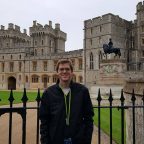 John Lisle
John Lisle
Hosts
 Joan NeubergerProfessor of History, University of Texas at Austin
Joan NeubergerProfessor of History, University of Texas at Austin
Let me start by asking someone to describe the project. Maria, what is “Behind the Tower: New Histories of the UT Tower Shooting?”
Maria: This project was born out of a public history seminar that we held in the spring. We were 11 students under your guidance, Dr Neuberger, and we decided to focus on this particular history of August 1, 1966 because we felt that there was a gap, a history that has not been told. We felt that it needed commemoration and it needed remembering so we started doing research on what happened, the individuals involved, and how it affected our community, not just UT Austin, but Austin as a whole, and perhaps in the larger scheme, Texas and the nation.
John, maybe you could tell us what we were studying. What happened fifty years ago on August 1?
John: The tragic events of August 1, 1966 started when Charles Whitman killed his mother and his wife in the early morning hours. He eventually made his way to the University of Texas where he went up to the top of the UT tower, to the observation deck along with an arsenal of weapons that he brought with him, he started shooting at the innocent people below, many of them students who were there for their summer classes. He ended up wounding or killing over 40 people until he was eventually confronted by a couple of police officers on top of the tower where they killed Whitman after the rampage had lasted about 96 minutes.
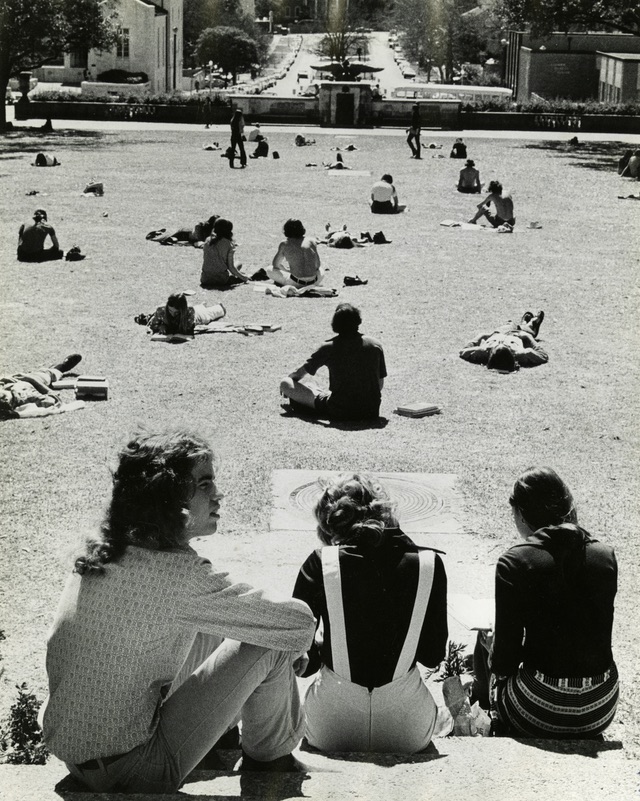
You could argue that this is one of the most important historical events to take place in Austin. Why did we decide that it was important to tell the story?
Rebecca: One of the things that surprised us looking into this incident was that although there had been oral histories done on the shooting and a lot of journalistic treatment of it, there was a lack of historical treatment. There were a lot of questions we found ourselves asking that hadn’t been asked at all or had only been asked from a journalistic point of view. So we did a lot of work in local archives to try to get some answers to those questions and we found a lot that surprised us frankly.
Itza: Let me add to that the intention of this project, being a public history, a history that is for the public to consume, we really wanted it to be accessible as well and regardless of your age or your background, we wanted these histories to be digestible, to be understandable, and not just your typical academic writing.
We want this to be part of the community’s history and available for the whole community because it is really a community story, a community history.
Maria, it’s often referred to as the first mass shooting; is that true?
Maria: As a matter of fact, no. After looking at the archives and the historical newspapers, –we went to the Briscoe Center [for American History] and the Austin History Center as well — I found out that there were at least six shootings by a single shooter that occurred on a school property. The first one I was able to find was in 1891, in Liberty Mississippi. This has been a misconception that this was the first mass shooting in the country.
And why do you think we have this misconception?
Maria: I think that what the documents told me was that we have a tendency as a society to forget. Perhaps when tragic moments happen we use forgetting to help us move on or to help us heal and I think that this creates a collective amnesia that perpetuates this sense of forgetting. But what I found was that every time an incident happened that particular incident was considered by the media at that moment as a first, but then by the time the next one happened the previous one had already been forgotten and everyone thought it unprecedented. By the time the shooting in 1966 happened people were calling it the first mass shooting when in fact it wasn’t.
A lot of people today don’t want people to focus on perpetrators of mass shootings. For a lot of reasons: they think that it encourages copy cats or they think it gives too much attention to people who commit mass atrocities.
Rebecca what do you think about this?
Rebecca: I think that those are really legitimate concerns that as public historians we need to consider in our work. At the same time, I think that there’s a great need to understand why these events take place, especially in a time when mass shootings, especially in schools are on the rise and there are so many of aspects of the story that haven’t been told. People tend to point to one factor or another to explain why Whitman did what he did. Be it that he was a victim of abuse from his father, or that he was simply a psychopathic monster, and there are so many aspects of his life that we’ve looked at in this project that I think contribute to a broader discussion of how we can help events like this from happening in the future.
Can you give one example from your own research of something that helps us understand what Whitman did?
Rebecca: One aspect that I focused on, that I was surprised hadn’t been discussed much, was Whitman’s serious substance abuse. He was a heavy abuser of dexedrine, which is a drug similar to ritalin, typically used to treat ADHD, as well as tranquilizers. And while it was not unusual in the 60s for students to use this drug to stay awake as a study aid, it was unusual to have it in the quantities that he did, getting it from multiple pharmacies. So there was an FDA investigation at the time because they considered this to be a case of possible criminal substance abuse or possibly dealing. Whitman did distribute drugs to his friends or at least offered to, from what we can tell. This was very unusual for somebody at the time.
So the fact that he took these gigantic amounts of drugs, would stay awake for days on end, his behavior was notably different to his friends. And his friends were very surprised that in the aftermath of the incident that this was a topic that wasn’t discussed more often. The FDA brought up the fact that once the tumor in his brain was discovered so much attention was focused on that, that the drug issue fell to the way side.
And what about then, the university’s response to the shooting?
Itza you’ve done some research on this aspect of it and on the responses at the time to trauma and the culture of dealing with trauma at the time.
Itza: In my research, I really looked at how different groups, and in particular the university as a group reacted to the UT tower shooting. In the last 50 years the reactions and degrees of reactions have varied so much. So, for example, in the late 1990s, under the direction of President Faulkner, we saw much more discussion, talking about the incident. This is when we saw efforts to renovate what was the turtle pond and to include a plaque to commemorate and to acknowledge that event, but other years we really just see a silence.
And the 1999 discussion was really the first in decades, right?
Itza: Yes, and Faulkner, I think it should be noted, that he was a student at that time
In 1966?
Itza: Yes, so there was even more pressure from him to acknowledge this because he had lived his own experience and he wanted to pay tribute to the other people who had lived it with him. But in the first, second, and third decade we don’t really hear about it at all, much less in the public sphere. Maybe behind closed doors, but in the archive you really see what we would call a “silent archive” where there’s no mention of it at all or it’s hard to find or it’s called something else. Fifty years later there has been a resurgence of this conversation. In particular I think we need to note that this conversation came from survivors and not from the university administration. When they commemorate the new plaque [on August 1, 2016], this effort was led by survivors. And so for fifty years reactions have varied and they probably will continue to vary.
Itza, you’ve also done a lot of studies of trauma and responses to trauma. How does that help us understand what happened?
Itza: In connection with my research about how we remember, I’ve noticed a lot of discrepancies about how some people really want to remember actively and we see this a lot in the reactions to the first plaque and how small it was and how much we weren’t talking about this topic enough, but in other instances I saw when people were saying this changed my life in such a drastic way and I don’t want to remember it or I only want to remember certain parts of it. It was really interesting to see how such a violent incident in history can affect people in such different ways. And that conflict, of well, if we remember this every year does that cause pain to certain people but help others. So there’s that obvious tension. I think more conversation should be had as to how do we alleviate the tension and respect both sides or even people in the middle.
This is something we talked about in class. As historians we tend to think that we should tell everybody’s story and put as much information as we can out there and let people make their own decisions but because this was a project of public history you kept us conscious of how important it was to remember everybody’s sensitivities as well.
One of the topics that’s also really controversial has to do with the tower itself.
John is a tower guide so now that the observation deck is open again, John leads people on tours of the observation deck and he’s also done research into the history of the tower. What does the tower represent for people and how has it changed over the years?
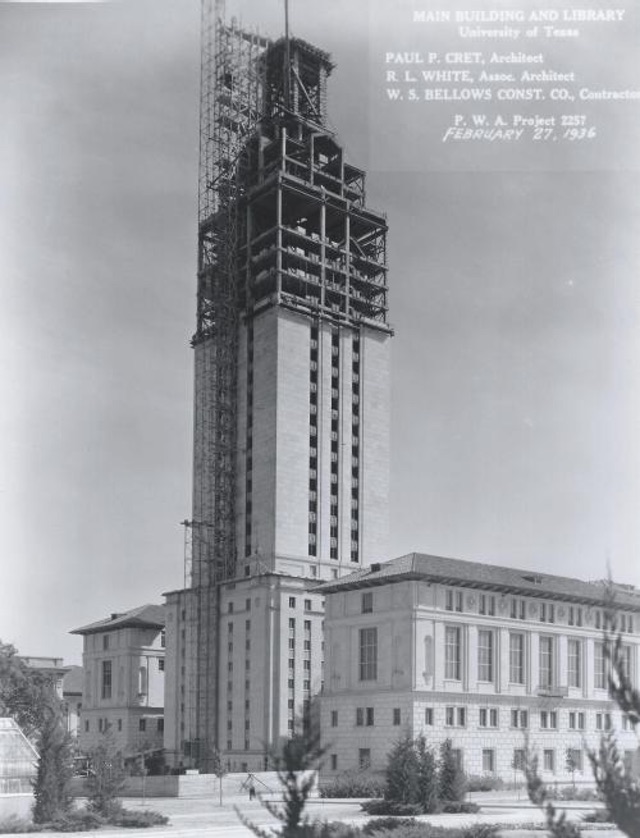
John: It’s definitely changed. Originally, the architect of the building, Paul Philippe Cret , wanted this big domineering tower in the skyline to represent the university. He wanted it to be the symbol of the university and back then it was the university’s main library as well though that’s shifted to PCL [the Perry-Castaneda Library] now.
In 1966, of course, the tower took on a new tragic meaning with the Whitman shooting and also after that there were some subsequent suicides that led to the closing of the observation deck and it kind of held that tragic meaning for a while. It was President Larry Faulkner in 1999, who wanted to reopen the tower. He wanted to reclaim the meaning of the tower, that was one of his goals in reopening the observation deck to the public, for them to be able to see what I consider the best view in Austin today.
So the tower has taken on several different meanings. Of course along with the positive associations we give to the tower today — it’s lit up after footballs games, when something good at the university happens, we light it up a burnt orange color — there are still tragic meanings and I think it’s important not to silence those tragic meanings. History is still history whether its good or bad and it’s important to know that, to know what happened at the university. But in addition to that I think the meaning of the tower is distinctive to individuals. Each individual has a distinctive meaning of it And I think that’s evident over the years with the shifting meaning of the tower.
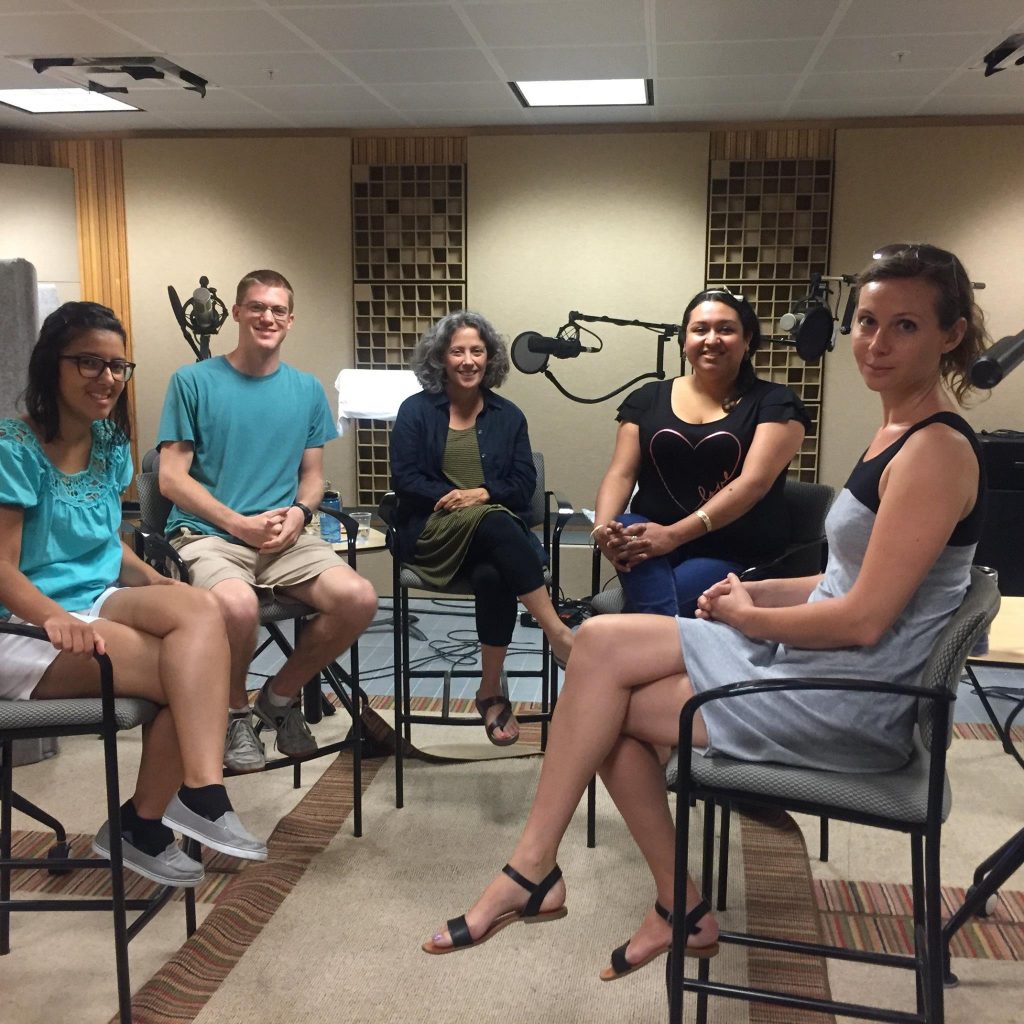
Let me ask everybody: we went of tour of the tower, John took us on the tour. It’s open now on weekends and you can sign up for a tour and go up there. Sid that change how you saw the history by just going up there?
Maria: I think that it gave me a different perspective of how to take this history. When I first came to Austin, I didn’t know much about the shooting or what the tower represented or what it didn’t represent, but after doing this research and going up to the tower to see what you [John] consider the best view in town, I started feeling like it gave me more of a personal connection to this project. I was able to see where Whitman was standing when he was shooting down. I was able to see where people who are considered heroes like Ramiro Martinez and Houston McCoy shot Whitman and the tragedy after 96 minutes.So it did change my perspective on this project, definitely.
Rebecca: I can just add that I was surprised at the very visceral reaction I had to being in the tower. I thought it was kind of disturbing. The entire experience felt like I was walking into a prison complex with all the caging everywhere, especially up on the observation deck. It felt very cold. I really didn’t expect it to feel that way.
Charles Whitman planned to make it a fortress he brought a trunkful of supplies thinking that he was going to stay there for a while.
Rebecca: including all his drugs.
Including all his drugs, and canned food and a huge amount of ammunition and a number of guns. I found it very personally moving as well. I found it very disturbing to be able to stand there and see where he was shooting from and get a sense of what it meant to pick someone off walking across the plaza. But at the same time it reinforced my own personal involvement with the people whose lives were ended or really scarred that day. One of the things that we thought was important was to write biographies of everyone who was either killed or wounded. I felt that after working on that part of the website that I was even more invested in people’s lives. I felt like during the course of the semester I’d gotten to know everyone who’d been involved. Charles Whitman himself, the people who were wounded or killed, as well as many of the heroes who helped drag people out of the line of fire or get them into ambulances.
I really think that you guys, the graduate students who did most of the writing for this project, did a fantastic job, covering a lot of historical topics. Let me conclude by saying that all the students’ essays are available on our website: behindthetower.org
And in addition to the things that we talked about today, it includes essays on Charles Whitman himself, his murder of his wife and mother, on UT in the 1960s — the political context of the shooting. There are two essays on gun culture in Texas in the 60s, on the media response, and we end with an update on the new memorial, which is a big, beautiful rock that’s been put up near the turtle pond that’s now really visible. We’re taping a couple days before it’s going to be unveiled on August 1, 2016. So we hope you’ll go look at our new public histories.
Behind the Tower: New Histories of the UT Tower Shooting also includes a list of Further Reading and Biographies of the people killed and wounded by Charles Whitman.


